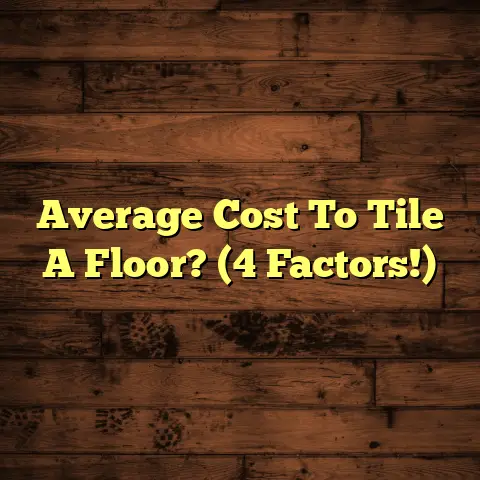How To Make Porcelain Floor Tiles Shine? (Explained)
When I first started working with porcelain floor tiles, I held a common misconception that once they were installed, they required little to no maintenance. I thought their durability would mean they would always look pristine. However, over the years, I learned that keeping them shiny and beautiful takes more than just routine cleaning. This realization has shaped my approach to maintaining porcelain tiles, and I want to share what I’ve discovered along the way.
The Basics of Porcelain Tiles
Porcelain tiles are known for their strength and low porosity, making them a popular choice for both residential and commercial spaces. However, despite these advantages, they can lose their shine due to dirt, grime, and residue buildup. One of the first projects I worked on involved a large commercial space with a beautiful porcelain tile floor that had dulled over time. It was a challenge to bring back its original luster, but it taught me valuable lessons.
Cleaning Techniques That Work
To restore shine effectively, I’ve experimented with various cleaning methods. Here are some techniques that have yielded great results for me:
- Regular Sweeping and Mopping: Daily sweeping removes loose dirt and debris. I prefer using a soft-bristle broom or a microfiber mop to prevent scratches. Mopping with warm water is key—just don’t use too much water, as standing water can lead to issues.
- Vinegar Solution: For deeper cleaning, I mix one part white vinegar with three parts water. Vinegar is a natural cleaner that helps break down grime without damaging the tiles. However, I avoid using it on any grout lines, as it can weaken them over time.
- Commercial Tile Cleaners: Sometimes, I turn to specialized cleaners designed for porcelain tiles. These products are formulated to lift tough stains and restore shine without harming the finish. I always check that the cleaner is pH-balanced and safe for use on porcelain.
My Experience with Polishing
After cleaning, I often polish the tiles to enhance their shine further. A high-quality porcelain tile polish can make a significant difference. I apply it using a soft cloth in small sections, buffing it in circular motions. I’ve found that this step really brings out the depth of the color in the tiles.
During one of my projects in a local restaurant, the owner wanted a quick turnaround on restoring the tiles after a major event left them dull. With a combination of thorough cleaning and polishing, we transformed the floors in just a few hours, much to the delight of the owner.
The Grout Factor
One aspect I’ve learned not to overlook is grout maintenance. Over time, grout can become discolored and detract from the overall appearance of porcelain tiles. I typically use a toothbrush and a baking soda paste (made with water) for spot cleaning grout lines. This method has served me well, especially in high-traffic areas where dirt accumulates quickly.
Cost Considerations
When working on any flooring project, cost estimation is crucial. One tool that has been invaluable for me is FloorTally. It helps me generate accurate cost estimates based on local material prices and labor rates. For instance, when I was working on a residential project that included porcelain tile installation in a 1,500 square foot area, FloorTally provided detailed estimates for materials and labor costs.
I could input various tile options and see how each choice impacted the budget. This functionality allowed me to present my clients with realistic financial plans right from the beginning—building trust and ensuring transparency.
Tackling Challenges
While I’ve had successes in restoring shine to porcelain tiles, challenges have also cropped up. For instance, during one project in an older home, I encountered tiles that had been improperly sealed before installation. This led to staining that was much harder to remove than I initially anticipated.
In situations like this, I’ve learned to adjust my approach by utilizing stronger commercial-grade cleaners or even considering professional restoration services when needed. It’s all about being adaptable and recognizing when something requires a different strategy.
Tips for Long-Term Maintenance
To keep porcelain tiles shining over the long haul, I’ve developed a routine that works well for me:
- Use Floor Mats: Placing mats at entryways helps capture dirt and moisture before it reaches the tile surface.
- Avoid Harsh Chemicals: Some cleaners can strip away protective coatings on tiles. It’s essential to choose products specifically designed for porcelain.
- Seal the Grout: After cleaning and restoring grout lines, applying a grout sealer can help prevent future staining.
My Favorite Cleaning Products
Over the years, I’ve tried numerous cleaning products for porcelain tiles, and I’ve found several that stand out:
- Zep Neutral pH Floor Cleaner: This cleaner is safe for regular use on porcelain tiles and doesn’t leave behind any residue. It’s particularly effective at removing light dirt without dulling the finish.
- Rejuvenate All Floors Restorer: When I’m looking to give my tiles an extra shine after deep cleaning, this product works wonders. It provides a protective layer that enhances gloss while also helping to fill in minor scratches.
- Bona Stone, Tile & Laminate Floor Cleaner: This eco-friendly option is excellent for regular maintenance and leaves no film behind. It’s gentle enough for frequent use but tough on dirt.
Dealing with Stains
Stains can be one of the most frustrating issues when it comes to porcelain tiles. From red wine spills to pet accidents, knowing how to tackle stains effectively is crucial.
- Immediate Action: The sooner you address a stain, the better your chances of removal. For example, I once spilled coffee on my kitchen tiles during breakfast rush hour. I quickly blotted it up with a paper towel before it set in, which made all the difference.
- Baking Soda Paste: For tougher stains, I create a paste using baking soda and water. I apply it directly to the stain and let it sit for 15-20 minutes before scrubbing gently with a soft brush.
- Hydrogen Peroxide: For stubborn stains like ink or paint, I’ve used hydrogen peroxide applied carefully with a cotton ball or cloth. It’s important not to soak the area; just dab gently until the stain lifts.
Enhancing Shine with Sealing
Regular sealing can also play a significant role in maintaining the shine of porcelain tiles. While many porcelain tiles are already glazed and don’t require sealing, it’s worth checking if your specific tiles benefit from an additional layer of protection.
- Choosing the Right Sealant: If sealing is appropriate for your tiles, choose a penetrating sealant designed for porcelain or ceramic surfaces. This helps repel moisture and stains without altering the appearance of the tile.
- Application Process: I ensure that my tiles are clean and dry before applying sealant, using a foam applicator for even distribution. After applying, I let it sit according to product instructions before buffing off excess.
- Schedule Regular Resealing: Depending on foot traffic and usage, resealing every 1-3 years can help maintain both shine and protection against stains.
Customizing Your Porcelain Tile Choices
Another aspect I’ve enjoyed while working with porcelain tiles is customizing choices based on client preferences or project requirements:
- Color Variations: Porcelain comes in numerous colors and finishes—from glossy whites to matte blacks—allowing me to match any aesthetic preference.
- Texture Options: Some clients prefer textured tiles for slip resistance in wet areas like bathrooms or kitchens. Understanding these needs helps me recommend suitable options from my experience.
- Size Matters: The size of tiles impacts both appearance and maintenance; larger tiles often mean fewer grout lines but can be trickier to install correctly in uneven spaces.
The Installation Process
While restoration is important, understanding the installation process of porcelain tiles also plays a role in their long-term maintenance:
- Subfloor Preparation: A solid subfloor is essential for preventing cracking or movement over time. I’ve learned that ensuring proper leveling can save headaches later on.
- Tile Layout Planning: Before laying tiles down, I map out my design to minimize cuts and maximize aesthetics. It’s often helpful to dry lay tiles before adhering them to get a feel for how they will look.
- Using Thinset Mortar: Applying the right thinset mortar is key; I tend to use modified thinset for added strength and flexibility, especially in high-traffic areas.
- Grouting Techniques: Proper grouting not only enhances appearance but also protects against moisture penetration. I always make sure to use grout spacers during installation for uniform gaps.
The Role of Temperature and Humidity
Interestingly enough, environmental factors play an important role in both installation and maintenance:
- Temperature Considerations: During installation, it’s best to work in temperatures between 50°F and 100°F (10°C to 38°C). Extreme temperatures can affect how adhesives cure.
- Humidity Levels: High humidity can slow drying times for adhesives and grouts; conversely, very low humidity can cause rapid drying leading to cracks or weak bonds.
- Post-Installation Care: After installation, I recommend clients avoid heavy foot traffic for at least 24-48 hours to allow everything to cure properly.
Success Stories from My Projects
Throughout my career as a flooring contractor, I’ve encountered various projects where porcelain tile restoration became an art form:
- A Local Spa Retreat: This upscale spa featured stunning large-format porcelain tiles that needed refreshing after several years of heavy use. After deep cleaning and polishing, we transformed the space into an inviting oasis again—clients were thrilled!
- A Family Home Renovation: In this case, we were tasked with replacing old flooring with new porcelain tiles throughout a busy household with kids and pets. By applying protective sealants right after installation and establishing regular cleaning schedules with the homeowners, we managed to keep those floors looking newly installed even years later.
Comparing Porcelain Tile Brands
When selecting porcelain tiles for projects, I’ve noticed varying quality among brands that can impact both shine and durability:
- Daltile: Known for its wide range of styles and finishes; their products tend to hold up well against wear while maintaining shine over time.
- Marazzi: Offers beautifully designed options but may require more frequent maintenance compared to others due to their unique finishes.
- American Olean: Provides budget-friendly choices without sacrificing quality; many homeowners appreciate how easy their tiles are to maintain.
Learning from Failures
Not every project has gone smoothly; I’ve encountered challenges that taught me invaluable lessons:
- Improper Sealing Issues: In one instance, I failed to properly seal grout lines during installation leading to discoloration within weeks—this taught me the importance of thoroughness during every step of installation.
- Mismatched Expectations: There have been occasions where clients expected high-gloss finishes only to choose matte options; clearer communication beforehand could have saved some misunderstandings down the line!
Community Insights
Engaging with other contractors in forums or groups has provided additional tips worth sharing:
- Temperature Control During Installation: Many pros emphasize using heaters or fans during cold months when working indoors as temperature affects adhesive curing times significantly.
- Online Tutorials: There are fantastic resources available online that demonstrate specific techniques visually—sometimes seeing someone else perform an action clarifies best practices better than reading about them!
- Client Education: Educating clients about ongoing care practices helps prevent future issues; regularly scheduled follow-ups can be beneficial in ensuring satisfaction long after installation is complete!
Conclusion
Maintaining porcelain floor tiles might seem daunting at first, but with the right techniques and tools, it’s entirely achievable. From regular cleaning practices to knowing when to polish or seek professional help, these steps have proven effective in keeping tiles looking their best.
What challenges have you faced with your porcelain tiles? If you’re considering new flooring or have questions about maintenance techniques, feel free to ask! I’m here to help navigate those decisions based on my experiences in the field.
By sharing these insights from my journey as a flooring contractor, I hope you feel equipped with actionable tips that will help you keep your porcelain floors shining bright!





